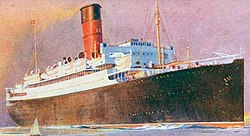RMS Lancastria
|
||||||||||||||||||||||||||
|
||||||||||||||||||||||||||
|
||||||||||||||||||||||||||
|
||||||||||||||||||||||||||
|
||||||||||||||||||||||||||
The RMS Lancastria was a British passenger ship operated by the Cunard Line shipping company . It was built in 1920 as Tyrrhenia for the Anchor Line , a subsidiary of the Cunard Line. During the Second World War , the Lancastria was sunk by the German Air Force on June 17, 1940 off Saint-Nazaire . There were many fatalities; the figures vary between 3,500 and 6,500 deaths. Due to the escape situation, the number of people streaming on board had not previously been determined.
Civil use

The ship made its maiden voyage on June 19, 1922. In 1924 it was converted to two passenger classes on the occasion of an expansion and renamed Lancastria . It operated the route between England and New York until 1932 and was then used as a cruise ship in the Mediterranean and Northern European waters.
Her sister ship was the Cameronia (II), launched in 1919 and commissioned in 1921 .
War enterprise
With the beginning of the Second World War, the ship was converted into a freighter and from April 1940 it was used as the HMT Lancaster troop transport. Her first assignment was to assist the Royal Navy in evacuating troops from Norway.
After a brief overhaul in Liverpool, the ship took part in Operation Ariel , the evacuation of British troops and citizens from France, under Captain Rudolph Sharp . It left Liverpool on June 14, 1940 and reached the Loire estuary on June 16.
Downfall
By the afternoon of June 17, the Lancastria was taking between 4,000 and 9,000 refugees (the official capacity was 3,000). This included British civilians as well as soldiers and other military personnel.
At around 4 p.m. there was an attack by Junkers Ju 88 fighter planes belonging to German Kampfgeschwader 30 . Three direct hits caused the ship to capsize and sink within twenty minutes. Over 1,400 tons of fuel leaked and some of them caught fire, possibly from fire.
2477 survivors were recovered. The Oronsay of the Orient Line , which had itself received heavy hits, participated in the rescue. The other passengers drowned, suffocated in the oil or were killed in the bombardment. It is about a third of all deaths suffered by the British Expeditionary Force during the French campaign .
Follow-up events
The British government tried to keep this great disaster secret ( D-Notice ). The survivors, as well as the crews of the ships they rescued, were ordered to remain silent and threatened with court-martial charges . On July 26th some newspapers like the New York Times , The Scotsman and The Vancouver Sun reported the sinking.
The wreck is located about 9 km south of Pointe de Chémoulin in the Charpentier Strait , about 17 km before Saint-Nazaire (position 47 ° 10 ′ 26 ″ N , 2 ° 19 ′ 15 ″ W ). To this day, the British government refuses to declare the wreck a war grave under the Protection of Military Remains Act of 1986 . The French government, however, has placed the area around the wreck under protection.
The captain, Rudolph Sharp, survived the sinking and became the captain of the Laconia . He died on September 12, 1942 when his ship was torpedoed by U 156 off the coast of West Africa .
literature
- Brian James Crabb: The Forgotten Tragedy. The story of the loss of HMT Lancastria. Shaun Tyas, Donington 2002, ISBN 1-900289-50-4 .
- Jonathan Fenby, The Sinking of the Lancastria. Britain's greatest maritime disaster and Churchill's cover-up. Simon and Schuster, London 2005, ISBN 0-7432-5930-0 .
Web links
- ( Page no longer available , search in web archives: image of Lancastria )
- Organization of the Lancastria survivors
- BBC report on Lancastria
- Reported July 26, 1940 in: The New York Times
Footnotes
- ↑ Norman Davies: Europa im Krieg , 2009, p. 144.
